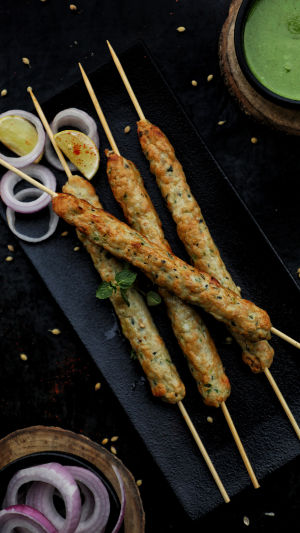Welcome Lykkers! Let's eat some Seekh Kebab is a popular Indian and Middle Eastern dish made from minced meat, typically lamb or chicken, and seasoned with a variety of aromatic spices.
The name "Seekh" refers to the skewers on which the kebabs are grilled, giving them their distinctive shape and texture.
Traditionally cooked over a charcoal fire, Seekh Kebabs offer a smoky, mouthwatering flavor that has made them a beloved street food and a restaurant favorite across South Asia and beyond.
<h3>Origins and History</h3>
The origins of Seekh Kebab trace back to the Middle East, where kebabs have long been a staple. With the advent of the Mughal Empire in India, kebabs became deeply integrated into Indian cuisine. The Mughal rulers were known for their love of rich, flavorful dishes, and they brought with them techniques for marinating and grilling meats. Over time, Seekh Kebabs evolved in India, incorporating local spices and herbs unique to Indian culinary tradition.
If we go according to the etymology of the dish, the word, "Shish" or "Seekh" means "sword" and "kebab" means "to roast". Legend has it that the dish originated in the open fields by the Turkish soldiers who used to take shelter in the jungle and hunt for wild meat.
Seekh Kababs became especially popular in the royal courts of Delhi, Lucknow, and Hyderabad, where chefs, known as "khansamas," developed their own versions of the dish. Today, Seekh Kababs are a favorite in North Indian and Mughlai cuisine and have inspired variations across Bangladesh, and parts of the Middle East.
<h3>Ingredients and Preparation</h3>
The key to a delicious Seekh Kabab lies in the use of fresh spices and quality minced meat. Traditionally, the ingredients for Seekh Kababs include:
<b>Minced Meat:</b> Lamb or chicken, finely minced for a smooth texture.
<b>Onions and Garlic:</b> Adds moisture and depth of flavor to the mixture.
<b>Green Chilies:</b> For a touch of heat, though the level can be adjusted.
<b>Spices:</b> Garam masala, coriander, cumin, black pepper, and sometimes fennel and nutmeg, which provide a complex, aromatic taste.
<b>Herbs:</b> Fresh cilantro and mint for added freshness.
<b>Binding Agents:</b> Bread crumbs or gram flour are often used to help bind the mixture and maintain its shape on the skewer.
The minced meat is mixed with spices and herbs and then molded onto skewers, giving it the cylindrical shape. Traditionally, these kababs are cooked over a charcoal grill, which imparts a smoky flavor. However, they can also be cooked in an oven or pan-fried for convenience.
<h3>Cooking Methods</h3>
While Seekh Kababs are ideally cooked over an open flame for an authentic taste, several methods can be used to prepare them:
<b>1. Charcoal Grill:</b> This is the traditional method, where the skewered kababs are cooked on an open flame or barbecue. The charcoal imparts a smoky aroma, enhancing the flavors of the spices.
<b>2. Oven Cooking:</b> The skewers are placed on a baking sheet and baked at a high temperature. This method is convenient for home cooks who may not have access to a charcoal grill.
<b>3. Pan Frying:</b> Seekh Kababs can be cooked in a hot skillet with a little oil. While this method doesn't provide the smokiness of a grill, it ensures a crispy exterior.
<h3>Serving Suggestions</h3>
Seekh Kababs are versatile and can be served in various ways. Traditionally, they are served with warm naan, fresh onions, and a side of mint chutney. The cool, herby chutney complements the rich and spicy flavors of the kababs. For a more elaborate meal, Seekh Kababs can be served with biryani or basmati rice, a popular option in Indian and Pakistani cuisine.
In street food settings, Seekh Kababs are often wrapped in paratha or roti with sliced onions, green chutney, and fresh coriander, creating a kabab roll or wrap that is perfect for eating on the go.
<h3>Regional Variations</h3>
Different regions have developed their own versions of Seekh Kababs, often based on local tastes and available ingredients. Some popular variations include:
<b>Shami Kababs:</b> Originating in Lucknow, India, Shami Kababs are softer, usually made with ground lentils added to the minced meat for a creamy texture.
<b>Chapli Kababs:</b> Popular in Afghanistan,Chapli Kababs are a flattened version of Seekh Kababs, often made with a mix of ground meat, spices, and chopped vegetables.
<b>Hara Bhara Seekh Kabab:</b> A vegetarian alternative, typically made with mashed potatoes, spinach, and green peas, providing a similar texture and flavor profile for those who prefer plant-based options.
<h3>Nutritional Value</h3>
Seekh Kababs are high in protein due to the minced meat, making them a satisfying meal. They also contain healthy spices that have antioxidant properties, including cumin and coriander. However, depending on the preparation method, they can also be high in fat, especially if cooked with added oil. Using lean meat and grilling rather than frying can make Seekh Kababs a more health-conscious choice.
<h3>Popularity and Modern Appeal</h3>
Seekh Kababs have transcended their Mughal origins to become a favorite worldwide, from Indian street food stalls to fine dining restaurants. They're also highly adaptable, with chicken and vegetarian options catering to various dietary preferences. Seekh Kababs remain a staple in Indian cuisine, beloved for their bold flavors and satisfying texture. They continue to evolve, with chefs experimenting with fusion versions and unique presentations that honor this traditional dish's roots while adapting it for contemporary tastes.





